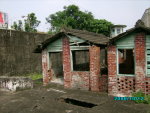Working
Purpose
In order to help inmates restore the goodness in their hearts and to help them keep up with the outside world and learn a skill, to allow them to have an income, and to spend their time, they are given work in the form of labor.
Work courses
The most unique characteristic of the Chiayi Prison factory is that it evinces local qualities. As early as 1922 under Japanese rule, the administration of Branch Warden Matsuda Matayoshi began to produce banana baskets (made from rattan) and Buddhist altar products; the Buddhist altar items were especially famous in Taiwan. In 1932, Branch Warden Muda Manjiro reclaimed approximately 20,000 ping of abandoned cemetery land. With further reclamations, 30,000 ping was ultimately developed; this area is the largest in Taiwan.
The factories maintained at the Old Chiayi Prison are as follows
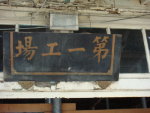
(The first factory)
(picture source:photo by this team)
- The first factory: has large and comprehensive set of woodworking machinery. Alishan had an abundant number of red cedar, which was very well-liked by the Japanese. Later, carpentry teachers from Chia-yi Industrial High School to instruct inmates, so inmates could have national-level licenses. As long as there is a blueprint, wooden products can be produced; in the early days the desks and chairs for Chiayi City Elementary School are produced by the first factory.
- The second factory: has comprehensive weaving equipment. Alishan had an abundant number of bamboo and rattan, and a large factory was established at Chiayi Old Prison that could produce bamboo and rattan products. The prison also cooperated with the Chiayi Winery to make wine baskets from rattan.
- The third factory: a printing factory; it was also constructed because of the abundant timber supply from Alishan. In the early days, the workbooks of middle and elementary schools in Chiayi City were made by the third factory!
- The fourth factory: a smaller factory that produces metal products.
- Farm: divided into internal and external farming, the purpose of which was to allow prisoners with shorter terms to work; when external farming, it required two or three people to be shackled together to prevent them from escaping. Produce from the farms were very abundant, such as yams, pineapples, tomatoes, and other foods. Other than internal consumption of in the prison, the rest could be sold to the outside, so the funds could be used to buy other types of food.
- Pig pen: next to the farm, there are small pig pens with chubby pigs in them. Here, the pigs are "lucky pigs" because their living spaces are even bigger than that of the inmates, and there is good lighting and ventilation, with inmates who massage and bathe them daily.
- Odd jobs, service staff: primarily helps to manage the working inmates, their scores must be higher than over level 2, and they have completed most of their term; the most important thing is to have trust of the supervisor. They can move around and have more freedom than other inmates.
Management of work
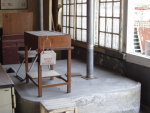
(Menagement of work)
(picture source:photo by this team)
When working in the factory, the door had to be closed to keep the inmates from going in and out as they please. In each factory of the Chiayi Prison, there is a supervisor, who can see all the movements of the inmates, even when they go to the bathroom. The supervisor would find a few trusted odd jobs and service personnel to help with quality control, inventory, and maintaining order. Since the tools in everyone's hands could be used as weapons, the managerial staff must be robust, experienced, and able to suppress inmates in order to be able to manage them. In the Old Prison, the factory director has been held hostage once, but in fact there is an alarm bell under the seat of the factory supervisor, which calls the central platform; if anything happens there can be immediate backup to quell the riots.
Scores
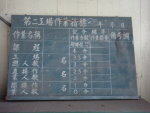
(Factory work billboard)
(picture source:photo by this team)
The modern prison uses the concept of "quantification" to analyze all aspects of life. Work at the factory is determined by the Department of Operations, as well as all the work hours and amount of work to be completed by the inmates. The instructions are written on the "factory work billboard" (image), and posted at easily seen places in the factory. New inmates begin with their original scores, then scores are calculated again at the end of the day after work is completed; those who produced more than the quota get 4 points, those who complete the work quota get 3.5 points, and so on. So-called "scores" are symbols of power, whereby managers use the power of scoring to better manage the inmates. When inmates apply for parole, other than the prison term, their scores while in prison are also accounted for.
Labor money
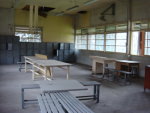
(Inside the factory)
(picture source:photo by this team)
Sources:
-
Researched and organized by this team
-
Interviews with Ms. Chiu Mr. Lee
-
Planning and Research Report on Renovation and Reuse of the Old Chiayi Prison as A Historical Monument of Chiayi City
-
Nanhua University Master's thesis: Construction of Three Dimensions in Arenas of Power Study of Chiayi City, Old Chiayi Prison, and the Body
